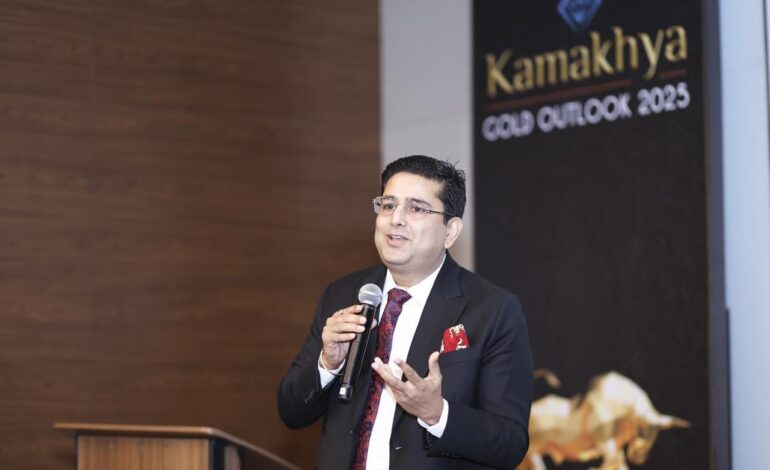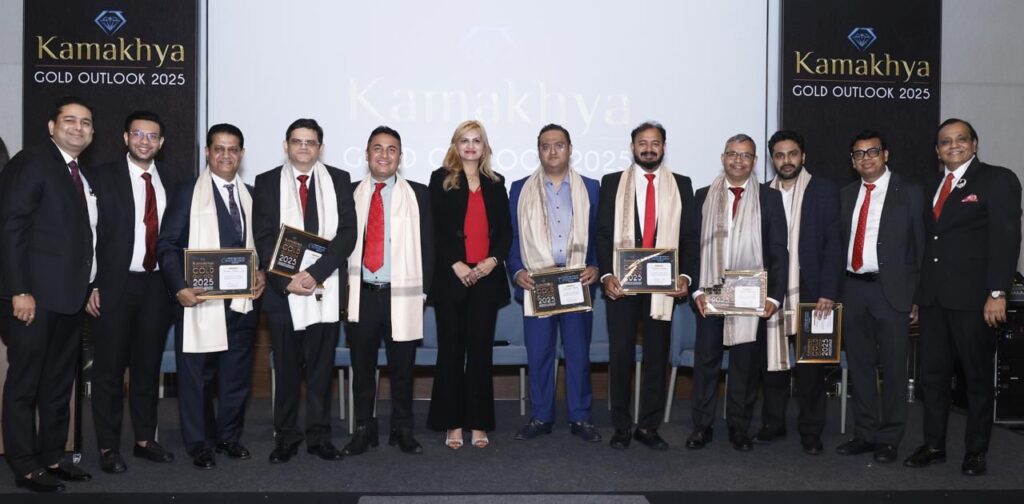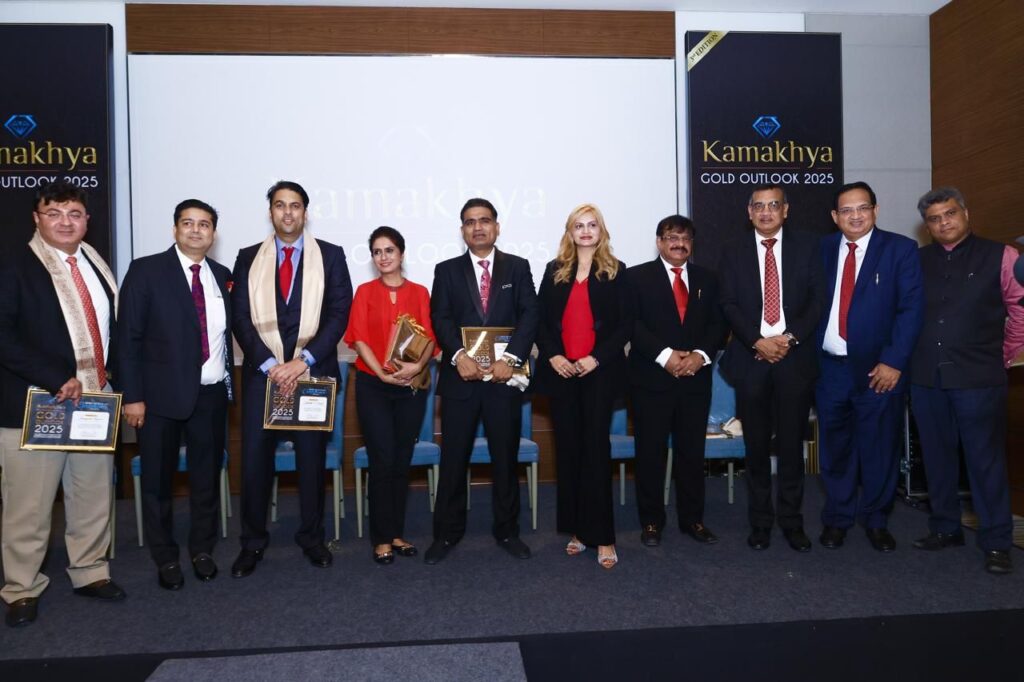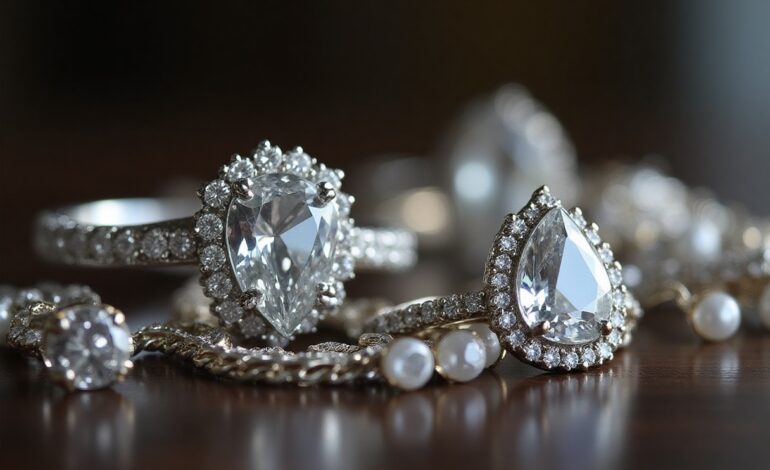$2,600 or $4,000? – The Golden Question for Gold in 2025

Will gold take a breather, or is another breakout on the horizon? As gold trades at record highs, the Kamakhya Gold Outlook 2025 brought together India’s top bullion voices to answer the golden question: Is $2,600 the next dip or $4,000 the next leap?
At the same event last year, experts had forecasted gold prices could touch $3,200, a prediction that proved remarkably accurate. This year’s wider forecast range of $2,600 to $4,000 reflects growing global economic uncertainty.
Held at the Jio Convention Centre in Mumbai on 11th April and hosted by Kamakhya Jewels Ltd, the third edition of the event drew a strong turnout from across the bullion trade, banking, financial services, and media. The mood was one of cautious optimism, shaped by inflation concerns, global trade tensions, and shifts in investor sentiment.
Mr. Manoj Jha, Managing Director, Kamakhya Jewels Ltd, opened the event, reiterating its purpose as a platform to guide rather than just observe.
“Kamakhya Gold Outlook was built to forecast with foresight. This year, we bring the widest range of views—and the strongest reasoning behind them,” he said.


Gold price outlook panel moderated by Mrituenjay Kumar Jha, Commodity Editor, Zee Business, Jewellery Panel moderated by Manisha Gupta, Commodity Editor, CNBC TV-18 and Market Volatility Panel moderated by Vishwamohan of ET now Swdesh. During the panel discussions, leading names from the industry shared their forecasts:
Prithviraj Kothari (RiddiSiddhi Bullions Ltd) was more cautious, emphasizing physical demand pressure: “Upside is limited as higher prices may trigger a sharp fall in physical demand,” he projected a top of $3,500, with potential downside to $2,600.
Kishore Narne (Motilal Oswal) offered a contrarian bullish take: “There’s no major reason for a price fall—gold may well touch $4,000 this year.”
Manoj Jha (Kamakhya Jewels Ltd) highlighted geopolitical triggers: “Upside may continue if the tariff war escalates, but any positive global news could lead to a sharp correction.” He placed his targets at $4,000 on the upside and $2,700 on the downside.
Kunal Shah (Nirmal Bang) projected a near-term correction toward $3,000–$2,950, followed by a rebound to $3,400–$3,450 by next year. “Major upside from this level is unlikely in the short term, but the long-term trend remains bullish,” Shah said.
Ajay Kedia (Kedia Advisory) presented a two-phase view: “Gold looks bullish in H1, but a bearish reversal can’t be ruled out in H2.” He forecasted targets of $3,540–3,600 for the first half, with a sharp correction to $2,350 possible in the second half.
Dr. C. Vinod Hayagriv (C. Krishniah Chetty Group) emphasized a phased outlook: “Expect stability near $3,200–$3,300 for 90 days, volatility next, and 8–12% upside by early 2026 toward $3,600. SIP-based buying is the way forward.”
Vikash Soni (L. Gopal & Sons Jewellers, Guwahati) offered a structured view: “Gold could hover around $2,800 in 3 months, $3,300 in 6 months, and $3,600 in a year.”
Hardik Parekh (Parekh Brothers Jewellers) expects stability around $3,200–$3,300 in the short term, with a possible dip to $2,900 in the next six months, before rising to $3,600 by early 2026.
Chahat Shah (Svaraa Jewels) foresees a peak of $3,800 by July, followed by a potential correction to $2,600 in the second half.
Bharat Seth (Batukbhai Sons Jewellers, Nagpur) echoed a bullish sentiment, citing strong retail demand and safe-haven buying as key drivers.
Market watchers highlighted several structural shifts behind these wide-ranging forecasts:
- De-dollarization and bond selling by large economies like China and Japan
- Investor retreat from U.S. Treasuries due to fiscal deficits and inflation
- Geopolitical tensions and tariff uncertainty impacting long-term stability
- Increased gold ETF inflows as an alternative to equities.
On the consumer side, jewellers like Dr. Saurabh Gadgil (PNG Jewellers) and Parag Bohra (Ratlam Jewellers) noted a rise in 18k jewellery demand, driven by affordability and design flexibility. Recycling of old gold now accounts for up to 55% of retail trade, indicating a more value-conscious market.
Retail expansion is also shifting gears. While urban markets are approaching saturation, suburban and tier-2 cities are emerging as the next growth hubs. Panellists agreed on one vital point: today’s jeweller must be more than a seller—they must be a trusted guide. Building lasting relationships with customers and offering genuine financial insight is now just as important as product and price.
In the discussion on sourcing, speakers like Varghese Alukkas of Jos Alukkas and Ashish Pethe of Waman Hari Pethe Jewellers stressed the urgency of building resilient, transparent supply chains. In an environment where global volatility and import reliance create constant challenges, they emphasized the need for smart hedging, agility and proactive planning.
As the event drew to a close, Mrs. Poonam Jha, Director at Kamakhya Jewels Ltd, offered a heartfelt note of gratitude. “Kamakhya Gold Outlook isn’t just an event—it’s a growing family of professionals committed to clarity and collective progress. We deeply appreciate everyone who shared their time, experience, and energy with us.”
Despite differing forecasts, one thing was certain: 2025 will be a landmark year for gold. Whether prices pull back to $2,600 or surge past $4,000, the journey ahead demands attention, adaptability, and informed decision-making from every stakeholder in the gold value chain.




